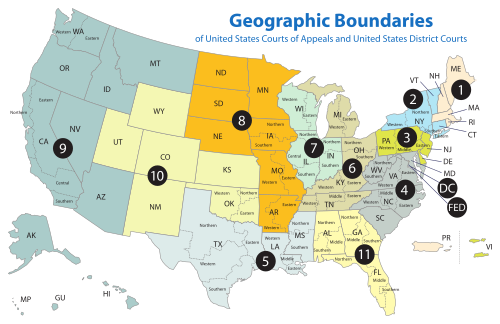United States District Court for the District of Alaska
| United States District Court for the District of Alaska | |
|---|---|
| (D. Alaska) | |
 | |
 | |
| Location | Anchorage show More locations |
| Appeals to | Ninth Circuit |
| Established | January 3, 1959 |
| Judges | 3 |
| Chief Judge | Timothy Mark Burgess |
| Officers of the court | |
| U.S. Attorney | E. Bryan Wilson (acting) |
| U.S. Marshal | Robert Heun |
| www | |
The United States District Court for the District of Alaska (in case citations, D. Alaska) is a federal court in the Ninth Circuit (except for patent claims and claims against the U.S. government under the Tucker Act, which are appealed to the Federal Circuit).
The District was established on July 7, 1958, pending Alaska statehood on January 3, 1959.[1]
The United States Attorney's Office for the District of Alaska represents the United States in civil and criminal litigation in the court. As of February 26, 2021 the Acting United States Attorney is E. Bryan Wilson.
Organization of the court[]
The United States District Court for the District of Alaska is the sole federal judicial district in Alaska.[2] Court for the District is held at Anchorage, Fairbanks, Juneau, Ketchikan, and Nome.
Anchorage Division comprises the following borough/census areas: Aleutians East, Aleutians West, Anchorage, Bethel, Bristol Bay, Dillingham, Kenai Peninsula, Kodiak Island, Lake and Peninsula, Matanuska-Susitna, and Valdez-Cordova.
Fairbanks Division comprises the following borough/census areas: Denali, Fairbanks North Star, North Slope, Southeast Fairbanks, and Yukon-Koyukuk.
Juneau Division comprises the following borough/census areas: Haines, Hoonah-Angoon, Juneau, Petersburg, Sitka, Skagway, and Yakutat.
Ketchikan Division comprises the following borough/census areas: Ketchikan Gateway, Prince of Wales, and Wrangell.
Nome Division comprises the following borough/census areas: Nome, Northwest Arctic, and Kusilvak.
Current judges[]
As of February 18, 2020:
| # | Title | Judge | Duty station | Born | Term of service | Appointed by | ||
|---|---|---|---|---|---|---|---|---|
| Active | Chief | Senior | ||||||
| 10 | Chief Judge | Timothy Mark Burgess | Anchorage | 1956 | 2006–present | 2015–present | — | G.W. Bush |
| 11 | District Judge | Sharon L. Gleason | Anchorage | 1957 | 2012–present | — | — | Obama |
| 12 | District Judge | Joshua M. Kindred | Anchorage | 1977 | 2020–present | — | — | Trump |
| 5 | Senior Judge | H. Russel Holland | Anchorage | 1936 | 1984–2001 | 1989–1995 | 2001–present | Reagan |
| 7 | Senior Judge | James K. Singleton | Anchorage | 1939 | 1990–2005 | 1995–2002 | 2005–present | G.H.W. Bush |
| 8 | Senior Judge | John W. Sedwick | Anchorage | 1946 | 1992–2011 | 2002–2009 | 2011–present | G.H.W. Bush |
| 9 | Senior Judge | Ralph R. Beistline | Anchorage | 1948 | 2002–2015 | 2009–2015 | 2015–present | G.W. Bush |
Former judges[]
| # | Judge | State | Born–died | Active service | Chief Judge | Senior status | Appointed by | Reason for termination |
|---|---|---|---|---|---|---|---|---|
| 1 | Walter Hartman Hodge | AK | 1896–1975 | 1960–1966 | 1961–1966 | 1966–1975 | Eisenhower | death |
| 2 | Raymond Eugene Plummer | AK | 1913–1987 | 1961–1973 | 1966–1973 | 1973–1987 | Kennedy | death |
| 3 | James von der Heydt | AK | 1919–2013 | 1966–1984 | 1973–1984 | 1984–2013 | L. Johnson | death |
| 4 | James Martin Fitzgerald | AK | 1920–2011 | 1974–1989 | 1984–1989 | 1989–2011 | Ford | death |
| 6 | Andrew Kleinfeld | AK | 1945–present | 1986–1991 | — | — | Reagan | elevation to 9th Cir. |
Chief judges[]
Chief judges have administrative responsibilities with respect to their district court. Unlike the Supreme Court, where one justice is specifically nominated to be chief, the office of chief judge rotates among the district court judges. To be chief, a judge must have been in active service on the court for at least one year, be under the age of 65, and have not previously served as chief judge. A vacancy is filled by the judge highest in seniority among the group of qualified judges. The chief judge serves for a term of seven years or until age 70, whichever occurs first. The age restrictions are waived if no members of the court would otherwise be qualified for the position.
When the office was created in 1948, the chief judge was the longest-serving judge who had not elected to retire on what has since 1958 been known as senior status or declined to serve as chief judge. After August 6, 1959, judges could not become or remain chief after turning 70 years old. The current rules have been in operation since October 1, 1982.
Succession of seats[]
|
|
|
| ||||||||||||||||||||||||||||||||||||||||||||||||
See also[]
- Courts of Alaska
- List of current United States district judges
- List of United States federal courthouses in Alaska
References[]
- ^ https://www.fjc.gov/history/courts/u.s.-district-court-district-alaska-legislative-history, Legislative history, Federal Judicial Center
- ^ 28 U.S.C. § 81A
External links[]
- 1960 establishments in Alaska
- Alaska law
- Organizations based in Anchorage, Alaska
- United States district courts
- Courts and tribunals established in 1960

